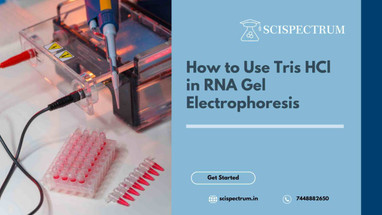Posted by Scispectrum on 22nd Aug 2025
Tris HCl in RNA Gel Electrophoresis: A Comprehensive Guide
RNA gel electrophoresis is a cornerstone technique in molecular biology in Tris HCl in RNA Gel Electrophoresis, allowing researchers to separate and analyze RNA molecules based on their size. At the heart of this technique lies the electrophoresis buffer, with Tris HCl playing a crucial role in maintaining optimal pH and ensuring the successful separation of delicate RNA molecules.
This article delves into the use of Tris HCl in RNA gel electrophoresis, covering everything from buffer preparation to troubleshooting tips, empowering researchers with the knowledge to achieve reliable and high-quality results.
Understanding the Role of Tris HCl
Tris HCl, short for Tris(hydroxymethyl)aminomethane hydrochloride, is a buffering agent widely used in biochemistry and molecular biology. In RNA gel electrophoresis, Tris HCl serves as a key component of the running buffer, playing a critical role in:
- pH Maintenance: RNA molecules are highly sensitive to pH changes. Tris HCl acts as a buffer, resisting changes in pH and maintaining a stable environment for RNA molecules during electrophoresis. This stability is crucial to prevent RNA degradation and ensure consistent results.
- Ion Conduction: Electrophoresis relies on the flow of ions to create an electric field. Tris HCl, being an electrolyte, provides the necessary ions for current flow, facilitating the movement of RNA molecules through the gel matrix.
Common Tris HCl Buffers for RNA Electrophoresis
Two commonly used buffers in RNA gel electrophoresis incorporate Tris HCl:
- TAE Buffer (Tris-Acetate-EDTA): TAE buffer is a versatile choice for RNA electrophoresis, offering good resolution for a wide range of RNA sizes.
- Composition: Typically prepared as a 1X solution containing 40 mM Tris base, 20 mM acetic acid, and 1 mM EDTA (pH 8.0).
- Advantages: Lower buffering capacity, which can be advantageous for longer gel runs and larger RNA molecules.
- TBE Buffer (Tris-Borate-EDTA): TBE buffer is known for its higher buffering capacity, making it suitable for extended electrophoresis runs and applications requiring higher resolution.
- Composition: Typically prepared as a 1X solution containing 89 mM Tris base, 89 mM boric acid, and 2 mM EDTA (pH 8.3).
- Advantages: Higher buffering capacity, better resolution for smaller RNA fragments, and less prone to overheating during prolonged runs.
Preparing Tris HCl Buffers: A Step-by-Step Guide
Accurate buffer preparation is crucial for successful RNA gel electrophoresis. Here’s a step-by-step guide to preparing 1X TAE and TBE buffers:
1X TAE Buffer Preparation:
- Calculate: Determine the required volume of 1X TAE buffer based on your experiment.
- Dissolve: Weigh out the appropriate amount of Tris base and dissolve it in distilled water (approximately 80% of the final volume).
- Adjust pH: Slowly add glacial acetic acid while monitoring the pH using a pH meter. Adjust to pH 8.0.
- Add EDTA: Add EDTA solution (0.5 M stock) to the desired final concentration (1 mM).
- Top Up: Add distilled water to bring the solution to the final volume.
- Sterilize: For long-term storage, filter sterilize the buffer using a 0.22 µm filter.
1X TBE Buffer Preparation:
- Calculate: Determine the required volume of 1X TBE buffer.
- Dissolve: Weigh out the appropriate amount of Tris base and boric acid and dissolve them in distilled water (approximately 80% of the final volume).
- Adjust pH: Check the pH and adjust to 8.3 using a pH meter if necessary.
- Add EDTA: Add EDTA solution (0.5 M stock) to the desired final concentration (2 mM).
- Top Up: Add distilled water to bring the solution to the final volume.
- Sterilize: For long-term storage, filter sterilize the buffer using a 0.22 µm filter.
Choosing the Right Buffer: TAE vs. TBE
The choice between TAE and TBE buffer depends on the specific requirements of your experiment:
- TAE: Preferred for routine RNA analysis, longer gel runs, and resolving larger RNA molecules.
- TBE: Suitable for higher resolution of smaller RNA fragments, extended electrophoresis runs, and applications where higher buffering capacity is crucial.
Tips for Successful RNA Gel Electrophoresis
- RNA Integrity: Use high-quality, intact RNA samples to ensure accurate results.
- Gel Concentration: Choose an appropriate agarose gel concentration based on the size range of your RNA molecules.
- Voltage and Run Time: Optimize the voltage and run time to achieve good separation without overheating the gel.
- Staining: Use a sensitive RNA stain, such as ethidium bromide or SYBR Green, to visualize the RNA bands.
Conclusion
Tris HCl is an essential component of RNA gel electrophoresis, ensuring optimal pH and ionic strength for the successful separation and analysis of RNA molecules. Understanding the role of Tris HCl, proper buffer preparation, and key considerations for successful electrophoresis will empower researchers to obtain reliable and insightful results in their RNA research.

